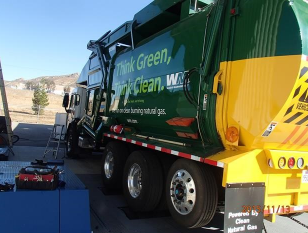A report released by the University of California Riverside’s (UCR) College of Engineering-Center for Environmental Research and Technology (CE-CERT) found that new ultra-low emission natural gas heavy-duty vehicles met and exceeded their certification standards during a full range of duty cycles.
According to CE-CERT, this finding is in stark contrast to its previously released data and a recently released report by the California Air Resources Board (CARB) that found heavy-duty diesel trucks emitted higher levels of nitrogen oxide (NOx) than their certification standards in the same duty cycles.
With the near-zero emission factors demonstrated for natural gas vehicles, it is expected that these vehicles could play an important role in providing much needed emissions reductions required for the South Coast Air Basin and California to reach federal air quality attainment standards.
“When comparing the data of the cleanest-available heavy-duty diesel vehicles versus the cleanest-available heavy-duty natural vehicles, it is clear that natural gas vehicles provide unmatched reductions of smog-forming emissions,” says Kent Johnson, author of the report. “These near-zero emission natural gas vehicles are especially effective in applications that require low speeds, such as short-haul goods movement.”
As reported, diesel-fueled medium- and heavy-duty vehicles are the No. 1 source of smog-forming emissions of NOx in almost every single metropolitan region in the country. NOx emissions lead to the formation of ozone and small particulate matter, each of which contributes to significant health impacts, including asthma and heart disease. In areas with the most severe air quality problems – such as central and Southern California – achieving healthy air quality will require a transition of heavy-duty vehicles to ones that emit zero or near-zero emissions.
The U.S. Environmental Protection Agency (EPA) has systematically reduced the allowable emissions of NOx from new heavy-duty engines since 1994 through application of progressively lower federal standards. With the 2010 NOx certification limit of 0.2 g/bhp-hr, NOx emissions dropped 90% compared with 2006 and older heavy-duty vehicles. Additional NOx reductions of another 90% are desired for the South Coast Air Basin to meet its 2023 NOx inventory requirements.
The report authored by Johnson evaluated the Cummins Westport ISL G near-zero engine emissions during typical in-use conditions. The engine was certified in fall 2016 by the EPA and CARB to 0.02 g/bhp-hr, which is 90% cleaner than the EPA’s current NOx emission standard and 90% cleaner than the cleanest-available diesel engine.
The report tested the ISL G near-zero engine on duty cycles that represent operations in the South Coast Air Basin. These cycles included the urban dynamometer driving schedule (i.e., city driving conditions); port cycles (including near dock, local and regional); refuse cycles; and central business district cycles.
According to CE-CERT, the report concludes that ISL G near-zero natural gas engines perform with NOx emissions below their certification level and that emissions decrease as the duty cycles decrease, meaning that in lower-speed scenarios, such as stop-and-go traffic commonly found throughout the South Coast region, the emissions decreased.
A separate report published in 2013 by the same author evaluated the in-use emissions of heavy-duty diesel vehicles with modern emission control systems in the same duty cycles and found that the diesel engines performed with up to five-times higher NOx emissions on average than their EPA certification standard and that emissions increased as the duty cycle decreased.
A report released in October 2016 by CARB reported similar findings: that in-use NOx emissions from heavy-duty diesel trucks were 1.7- to nine-times higher than the NOx certification standard. As the UCR and CARB reports found, these high in-use NOx emissions occurred primarily during low-speed operations, which is a concern in California, where low-speed operations are common, such as near port operations.







